Divisions and Classes of Kingdom Plantae.
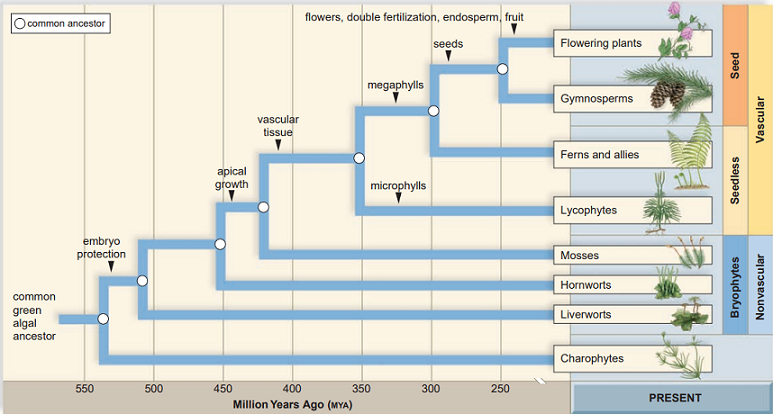
Divisions and Classes of Kingdom Plantae.
Land plants evolved from a common ancestor with multicellular, freshwater green algae about 450 MYA.
During the evolution of plants, protecting the embryo, apical growth, vascular tissue for transporting water and organic nutrients, possession of megaphylls, using seeds to disperse offspring, and having flowers were all adaptations to a land existence.
Plants are complex multicellular organisms that are photosynthetic autotrophs.
They have cellulose in their cell wall.
Most plants possess waxy cuticles covering most parts.
Reproduction is by both sexual and asexual reproduction.
Plants exhibit alternation of generation.
They also store excess glucose as starch.
The divisions in the kingdom Plantae are;
- Division Bryophyta (Bryophytes)
- Division Lycopodophyta (Clubmoss)
- Division Filicinophyta (Fern)
- Division Coniferophyta (Conifers)
- Division Cycadophyta (Cycads)
- Division Angiospermophyta (Angiosperms)
NOTE:
- Division Bryophyta, Division Lycopodophyta, and Division Filicinophyta are seedless plants.
- Division Coniferophyta and Division Cycadophyta are seed-bearing plants but their seeds are not enclosed in a fruit. They produce naked seeds. They are therefore called Gymnosperms.
- The gymnosperms and the angiosperms are collectively known as the spermatophytes (seed plants).
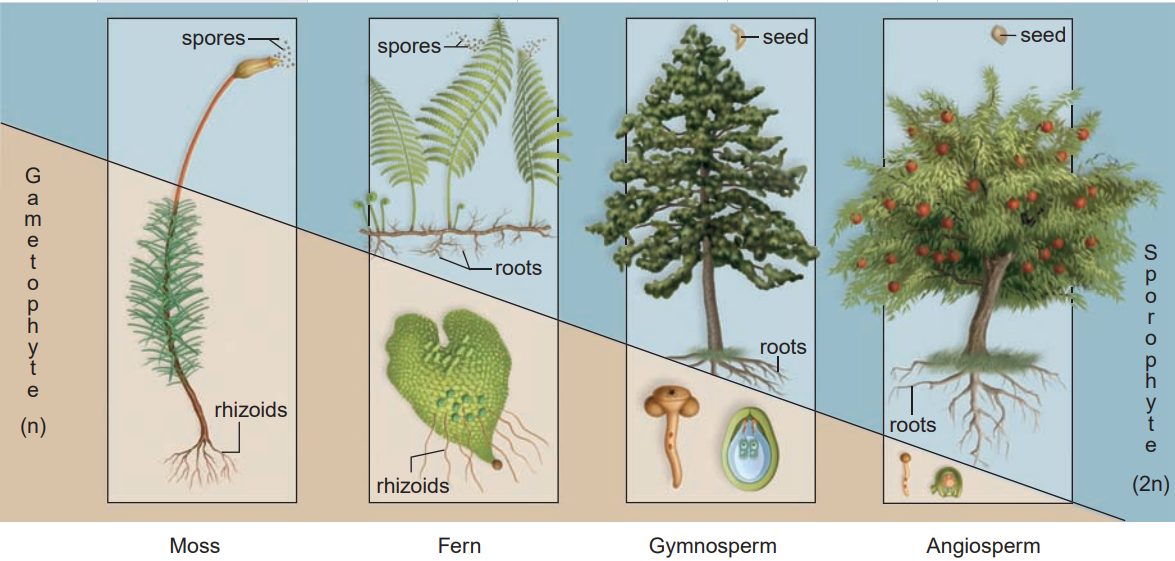
Division Bryophyta (bryophytes)
- Bryophytes lack cuticle.
- Absorb water by diffusion and capillary action across their body surface.
- They require water to reproduce.
- Because they have flagellated sperm which must swim through a water medium from the antheridium to the archegonium to fertilize the ovum.
- Antheridium which is the male gametangia produces flagellated sperms.
- The archegonium which is the female gametangia produces a single ovum.
- Bryophytes possess gametangia which protect developing gametes.
- Also, each bryophyte grips the substrate with rhizoids.
- The gametophyte is dominant to the sporophyte.
It has two distinct classes.
Class Hepaticae/Hepatophyta (Liverworts)
- The lack of vascular tissues
- They require water for reproduction (fertilization)
- Their body is divided into lobes.
- Can reproduce asexually from gemmae.
- A Gemma is a single cell, or a mass of cells, or a modified bud of tissue that detaches from the parent and develops into a new individual.
- Rhizoids are also unicellular.
Examples:
- Marchantia,
- Lepidozia,
- Blepharostoma,
- Riccia sp.,
- Scapania sp.,
- Conocephalum sp.,
- and Calopegia sp.
Class Musci (Moss).
- They possess upright gametophyte
- Their rhizoids are multicellular
- They also lack vascular tissues.
- Moreover, they require a water medium for fertilization
Examples;
- Funaria,
- Moss,
- Branchymenium,
- Polytrichum sp.,
- Mnium sp.,
- Dicranum sp.
Why are bryophytes restricted to damp habitats?
- Sexual reproduction in bryophytes requires moisture for the male sperm to swim to the female gamete.
- Bryophytes have no true root to absorb water and minerals, hence absorption of water and mineral salts occurs across their body surface by simple diffusion and osmosis.
- The plant surface lacks a cuticle, which makes absorption over the body surface possible.
Division Lycopodophyta (Clubmosses, quillworts, and spike mosses)
- They possess vascular tissue
- Have small scale-like leaves called mesophylls.
- Also, they lack true root, leaves, and stem.
- Sporangia is borne in a cone-like strobilus at the tips of the stem.
- The sporophyte is dominant, large, and conspicuous to the gametophyte.
Example:
- Selaginella sp.,
- Lycopodium sp.
Division Filicinophyta/Pteridophyta/Polypodiophyta (fern)
- They possess vascular tissue
- They have true roots, stems, and leaves.
- The leaves have many veins and are called fronds.
- Pteridophytes are terrestrial organisms.
- Spores are produced in the sporangia on the underside of the frond.
- The sporangia may form clusters which is known as sori.
- Moreover, they produce vegetatively by extending their rhizome underground.
- The gametophyte is small, tiny, green, and independent of the sporophyte.
- Gametophytes have no vascular tissue.
- Sporophyte is large and conspicuous; it is also the dominant generation.
Examples:
- Dryopteris,
- Platycerium,
- Nephrolepis.
Division Coniferophyta (Conifers)
- They are the largest group of gymnosperms.
- Their leaves are needle-like in shape.
- They have vascular tissues.
- Conifers have well-developed sporophytes.
- In conifers, the sporophyte is large, conspicuous, and dominant.
- Moreover, their reproductive structures are produced in cones.
- Pollination is mostly by wind.
Examples are;
- cedars,
- junipers,
- whistling pines,
- Araucaria heterophyl,
- Podocarpus sp.,
- Aibes sp.,
- Taxodium sp.,
- spruce.
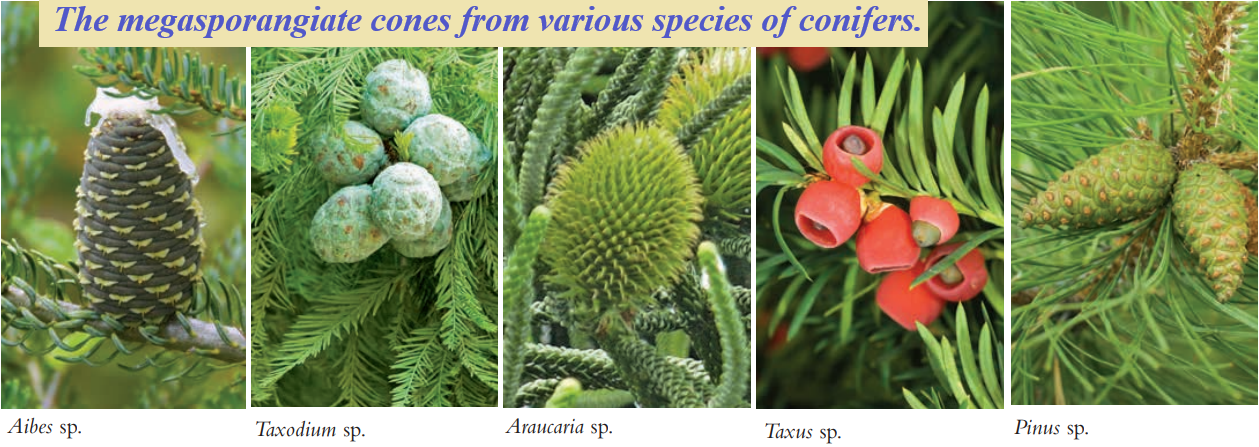
Division Cycadophyta.
- They look like palms and have palm-like leaves.
- Their leaves are tough and leathery.
- Leaves are pinnately divided into many leaflets.
- But the leaves are clustered at the tip of the stem.
- Cycads have very short unbranched stems.
- Cycads borne naked seeds without pericarp.
- Cones containing seeds are borne among the leaves at the apex of the tree.
Examples are;
- Encephalartos villosus,
- Zamia pumila,
- Cycas revoluta
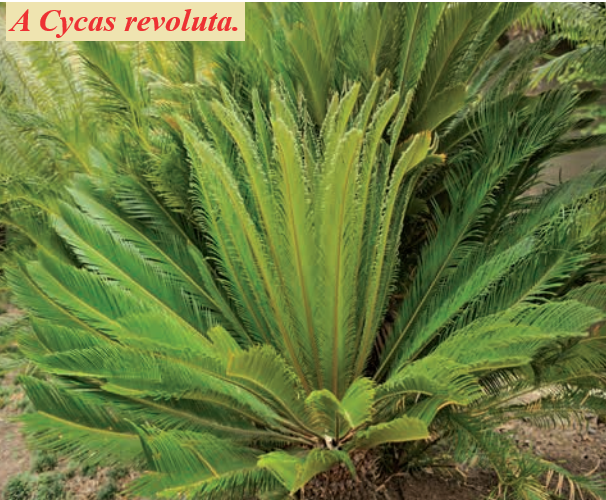
Division Ginkgophyta (Gingko)
- Gingko is heterosporous.
- They produce flagellated sperm and motile but are conducted to the vicinity of the egg by a pollen tube.
- Gingko are deciduous trees with fan-shaped leaves that have evenly forking veins.
- Seeds resemble small plums with fleshy, foul-smelling outer covering.
- Moreover, there is only one genus surviving.
For example;
- Ginkgo biloba, or maidenhair tree.
Division Angiospermophyta/ Magnoliophyta/ Anthophyta.
- They are the most widespread and diverse form of all plants.
- They produce flowers.
- Angiosperms undergo double fertilization with their sexual reproductive structure found in their flowers.
- The seeds of angiosperms are born in the pericarp (fruit)
- They have well-developed vascular tissue.
- Moreover, angiosperms are heterosporous.
- There are two main classes of Angiosperms
Class Monocotyledoneae
- They produce seeds with one cotyledon.
- Monocots have narrow leaves with parallel venation.
- Their vascular bundles are scattered in the stem.
- Monocots are mainly herbs because secondary growth does not occur in most of them.
- They also have a fibrous root system.
- Moreover, their leaves lack petiole but may have a leaf sheath.
- Floral parts are also arranged in threes or multiples of three.
Examples are;
- cereals,
- grasses,
- Cocos nucifera,
- Elaeis guineansis,
- Roystonea regia,
- plantain,
- bamboo.
Class Dicotyledoneae.
- Dicots produce seeds with two cotyledons.
- They normally have broad leaves with mostly net venation.
- They possess a tap root system.
- Dicots have left petiole in most cases.
- Also, their vascular bundles are arranged in a ring between the cortex and the pith in the stem.
- Moreover, dicots’ floral parts are arranged in fours or fives, or multiples of four or five.
- They undergo secondary growth or thickening.
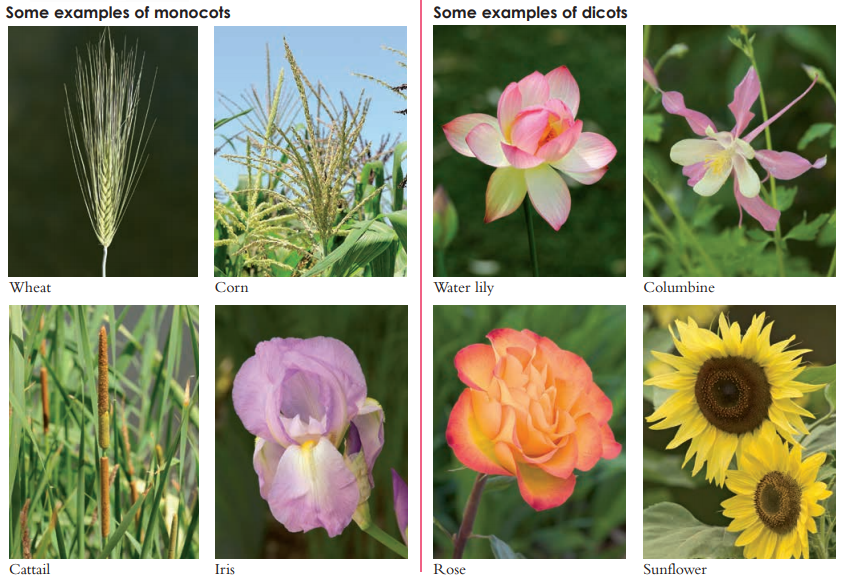
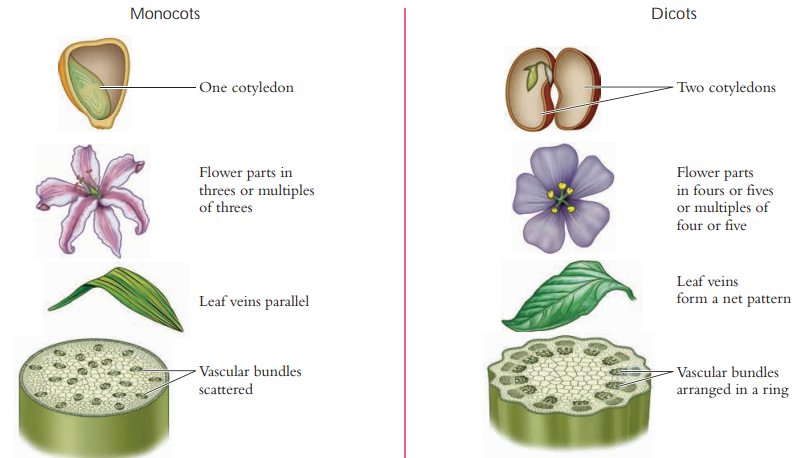
You might want to read;
- Life Process Moss and Fern.
- Plant nutritional requirement
- Plant Hormones
- Morphology of Angiosperms (flowering plants)
- Sample Essay Questions on Reproduction in Angiosperms
- Root structure and modification
Join Enlighten Knowledge WhatsApp platform.
Join Enlighten Knowledge Telegram platform.





